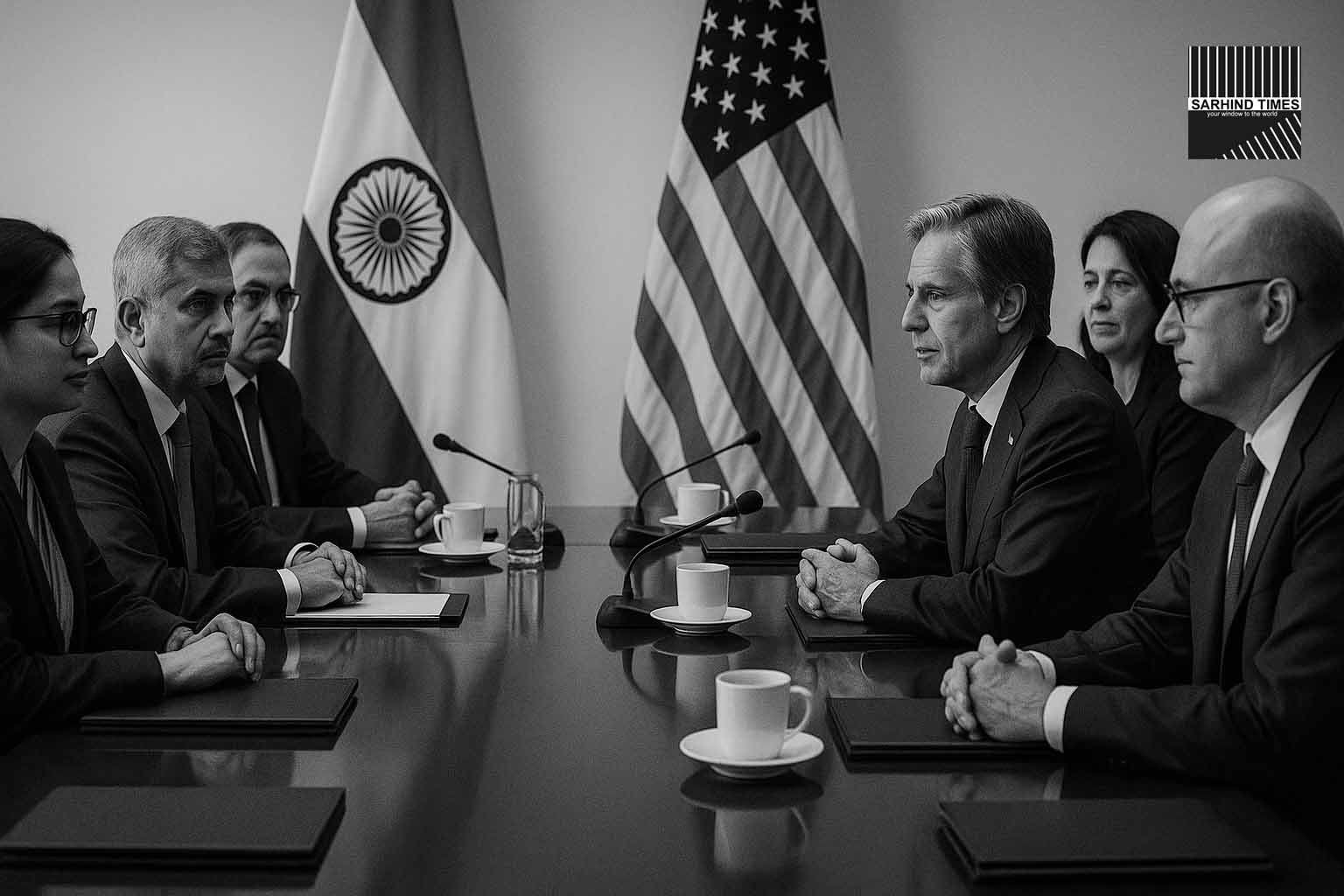High-level dialogue seeks pragmatic reset as both economies eye deeper cooperation
(By Sarhind Times Diplomatic & Business Bureau | October 16, 2025)
Washington / New Delhi — A New Round of Engagement
In what officials describe as a “constructive and forward-looking engagement,” a high-level Indian trade delegation has arrived in Washington this week to revive dialogue with the United States on long-pending trade issues, tariffs, and market access.
Leading the Indian side is Commerce Secretary Rajesh Agrawal, who is expected to join ministerial-level discussions later this week. The talks aim to resolve key disputes, strengthen supply chains, and boost bilateral investments.
According to sources familiar with the agenda, both nations are keen on identifying a “win-win pathway” that reduces friction on tariff-related disputes while expanding collaboration in energy, digital trade, and technology.
The visit comes at a time when global trade is under stress due to geopolitical shifts, supply disruptions, and energy security concerns — all of which make India–US alignment more strategically important than ever.
From Friction to Framework: Rebuilding Economic Trust
The India–US trade relationship, despite being robust and multifaceted, has weathered several bouts of friction in recent years — including disputes over agricultural exports, steel and aluminum tariffs, and data localization norms.
The current talks in Washington mark a step toward de-escalation. Indian officials are expected to push for:
- Tariff rationalization on Indian exports such as steel, aluminum, and textiles.
- Restoration of GSP (Generalized System of Preferences) benefits, which the U.S. withdrew in 2019.
- Market access for Indian pharmaceuticals, information technology, and agricultural products.
- Ease of standards and customs procedures for mutual benefit.
For the U.S., discussions will likely focus on:
- Greater energy exports to India, particularly LNG and crude oil.
- Opening up digital trade frameworks for smoother data transfers.
- Level-playing field assurances for American investors in India’s manufacturing ecosystem.
Energy Security: A Strategic Pivot
Energy cooperation is emerging as the new anchor in the bilateral economic narrative. With Washington eager to expand energy exports and India looking to diversify suppliers amid global volatility, both sides have found shared ground.
Sources indicate that India has expressed willingness to gradually increase U.S. energy imports, particularly natural gas and crude, as part of a long-term diversification plan.
This aligns with India’s goal of ensuring energy security while balancing commercial and geopolitical realities — especially following U.S. concerns over India’s discounted oil imports from Russia.
“Energy collaboration between India and the United States represents not just trade, but strategic trust,” said Dr. Ajay Dua, former Secretary, Ministry of Commerce. “It deepens mutual dependence in a volatile global energy landscape.”
Trade Balances and Numbers
India–U.S. bilateral trade has expanded sharply over the past decade, crossing $200 billion in goods and services in FY2024–25. The United States remains India’s largest trading partner, accounting for nearly 18% of total exports and 10% of total imports.
However, imbalances persist. India enjoys a trade surplus of around $40 billion, largely driven by software, pharmaceuticals, and engineering goods, while importing American aircraft, energy, electronics, and defense systems.
U.S. policymakers have occasionally flagged this gap, calling for greater reciprocity and regulatory transparency in India’s market. The current negotiations are an effort to bridge these differences through pragmatic collaboration.
Digital Trade, Standards & Investment Flows
Beyond tariffs, the Washington dialogue also encompasses the emerging areas of digital commerce, supply chain security, and sustainable investment.
The digital economy — a key pillar of modern trade — poses new challenges. Data sovereignty, privacy standards, and cross-border data flows are all on the table. Both sides seek frameworks that safeguard security interests while promoting innovation and investment.
Investment facilitation and mutual recognition of standards are equally critical. India is pushing for the removal of technical barriers that delay exports, while the U.S. is advocating fair access for American companies in India’s infrastructure and manufacturing sectors.
“These talks are about more than tariffs,” said a Washington-based trade analyst. “They’re about aligning the world’s two largest democracies on the architecture of future commerce — digital, green, and inclusive.”
Strategic Context: Politics Meets Policy
The timing of the talks is significant. U.S. President Donald Trump, in his latest remarks, claimed that Prime Minister Narendra Modi assured him India would not buy Russian oil — a statement that New Delhi has yet to confirm. This remark has injected new complexity into the trade dialogue, intertwining energy diplomacy with commercial negotiations.
Indian officials are expected to clarify their position and emphasize energy diversification rather than abrupt disengagement from any source. Meanwhile, both governments are keen to ensure the current trade talks are not derailed by political rhetoric.
Observers note that economic cooperation remains one of the most resilient pillars of India–U.S. relations, transcending electoral cycles in both nations.
Industry Voices: Seeking Predictability and Partnership
Indian exporters and industry bodies, including FIEO (Federation of Indian Export Organisations) and CII (Confederation of Indian Industry), have urged negotiators to focus on predictable tariff regimes, customs simplification, and standards harmonization.
Manufacturers, particularly in the pharmaceutical, textiles, and engineering sectors, believe that improved U.S. market access could significantly boost India’s exports.
“A stable and predictable trade regime with the U.S. will enhance investor confidence,” said A. Sakthivel, President of FIEO. “It’s time to move from friction to facilitation.”
U.S. business chambers have echoed similar sentiments. The U.S.-India Business Council (USIBC) welcomed the dialogue, emphasizing the need for long-term supply chain partnerships and clearer investment guidelines under India’s Make in India and PLI (Production Linked Incentive) programs.
Economic Stakes: The Cost of Delay
Unresolved tariff disputes have real costs. Indian exports of aluminum and steel have faced tariffs as high as 25% since 2018, reducing competitiveness and diverting trade flows to other markets.
Similarly, American agricultural exporters face non-tariff barriers in India, citing certification and labeling requirements. Analysts believe a structured deal could unlock billions in additional bilateral trade, while enabling both economies to better hedge against global uncertainties.
Supply Chain Resilience: Beyond Tariffs
A major agenda item is supply chain resilience — a global priority since the pandemic. India and the U.S. have collaborated through frameworks such as the Indo-Pacific Economic Framework (IPEF) to reduce dependency on China-centric supply routes.
The current talks aim to expand that cooperation through co-manufacturing agreements, semiconductor partnerships, and green technology transfers.
India’s ongoing outreach to global investors — in sectors from electronics to electric vehicles — dovetails with Washington’s efforts to de-risk critical supply chains. The two sides are expected to announce working groups focused on high-technology manufacturing and clean energy transition.
Diplomatic Tone: Constructive but Measured
Insiders describe the mood as “measured optimism.” There is recognition that both sides have domestic constraints — the U.S. grappling with political cycles, and India balancing industrial protection with liberalization.
The challenge lies in sequencing reforms and concessions so that neither side appears to be conceding too much.
“India and the U.S. are mature partners. Disagreements are inevitable, but they’re now handled through structured dialogue rather than public confrontation,” said Meera Shankar, former Indian Ambassador to Washington.
What Comes Next
A joint readout expected later this week will outline the timeline for working groups and potential deliverables. Focus areas include:
- Phased tariff reductions.
- Expansion of bilateral energy trade.
- Roadmap for restoring GSP-like benefits.
- Cooperation on digital standards and green technology.
- Strengthening customs and logistics infrastructure.
If successful, this round could pave the way for a larger trade framework later in 2026 — potentially setting the stage for an eventual India–U.S. Economic Partnership Agreement.
Conclusion: Partnership over Politics
The ongoing India–U.S. trade dialogue symbolizes a renewed commitment to pragmatic diplomacy — one that prioritizes economic growth, technology collaboration, and strategic balance.
Both sides recognize that their partnership is not just transactional but transformative — shaping how global trade, energy, and innovation evolve in the 21st century.
Whether on tariffs, technology, or trust, Washington and New Delhi appear determined to move from contention to convergence.
#IndiaUS #TradeTalks #Tariffs #Exports #Energy #BilateralTies #MakeInIndia #Commerce #GlobalEconomy #EconomicDiplomacy #WashingtonMeet #SupplyChains #Investment






















+ There are no comments
Add yours